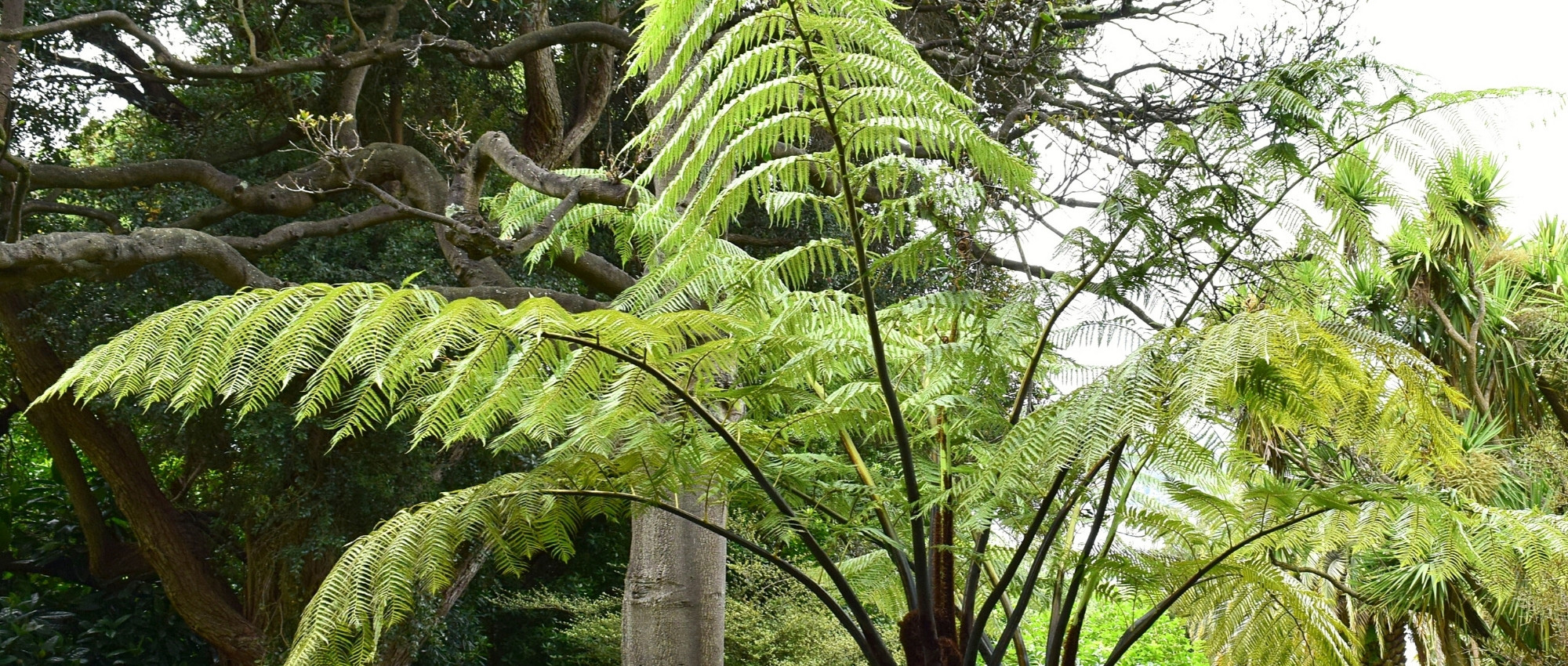
Cyathea: planting, growing, and care
Contents
Cyatheas in a nutshell
- Cyathea are stunning arborescent ferns
- They form an upright stipe and display large, beautifully divided fronds at the top
- They resemble palms but have much finer and more luxuriant foliage
- With their exotic style, they easily give the garden a jungle-like atmosphere!
- They thrive in shade or partial shade, in a relatively humid environment
A word from our expert
Cyathea is a splendid tree fern, forming a slender and tall stipe, crowned by large, finely divided light green fronds. Its presence alone brings an exotic and lush atmosphere. The most well-known and cultivated is Cyathea cooperi, which forms a tall stipe and a crown of tender green fronds. Also discover Cyathea dealbata, which bears fronds with a silvery underside, and Cyathea medullaris, distinguished by its black stipe and petioles!
Growing Cyathea is delicate and requires some precautions, but it is worth cultivating! It is a frost-sensitive plant that needs to be grown in a pot (except in the mildest regions of the Mediterranean or Atlantic coast) and brought indoors to a greenhouse or conservatory for winter. Cyathea requires cool, rather acidic soil and a humid atmosphere. It thrives in a sheltered position away from direct sunlight and wind. Finally, compared to other tree ferns like Dicksonias, Cyatheas have the advantage of growing more quickly. Discover all our tips for successfully cultivating them in this guide!
Botany
Botanical data
- Latin name Cyathea sp., Sphaeropteris sp.
- Family Cyatheaceae
- Common name Cyathea, tree fern
- Flowering none
- Height up to 5 – 6 metres in cultivation, and up to 15 m in their natural habitat
- Sun exposure partial shade
- Soil type cool, humus-bearing, rather acidic
- Hardiness -5 °C
Cyatheas are majestic tree ferns, whose silhouette resembles that of palms, but they offer much finer and more dissected foliage. They comprise around 320 species, native to the tropical and subtropical regions of the Southern Hemisphere, where they primarily grow in humid mountain forests. They are notably found in Eastern Australia (Cyathea cooperi, Cyathea australis…) and New Zealand (Cyathea dealbata), but some species also grow in Africa, Polynesia…
The Cyathea has given its name to the botanical family Cyatheaceae, which includes around 500 species. The species Cyathea cooperi has recently changed its scientific name and is now called Sphaeropteris cooperi. Its species name is a tribute to Daniel Cooper (1821-1902), a politician, merchant, and philanthropist of the 19th century.
The name Cyathea comes from the ancient Greek kyatheion, meaning “small cup,” referring to the sporangia, which are types of microscopic sacs containing the spores.
Cyatheas are prehistoric, very ancient plants. Ferns are among the first plants to have emerged from water and colonised dry land (long before the appearance of dinosaurs!). This explains why they remain dependent on water for reproduction and thrive in cool, moist environments.
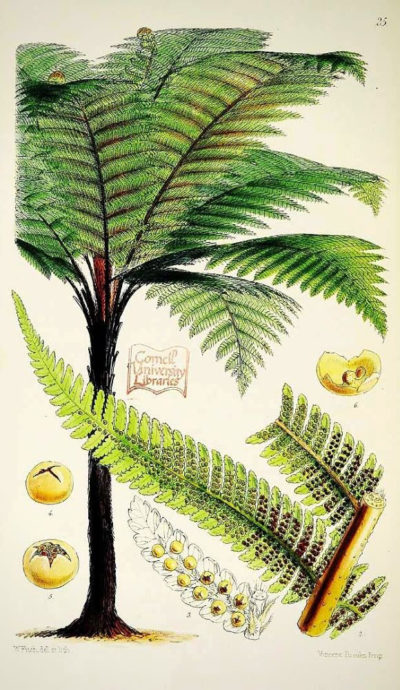
Cyathea medullaris: Botanical illustration
Cyatheas form a fibrous, brown stipe, quite slender and elongated, consisting of an upright rhizome surrounded by aerial roots and the bases of the petioles of old fronds. The stipe is slender and elongated, measuring between 10 and 20 cm in diameter, and can reach up to 30 cm in older specimens. The aerial roots present on the stipe allow the fern to capture atmospheric moisture. It is therefore important that the stipe remains consistently cool and moist.
The Cyathea medullaris is distinguished by its black stipe and petioles, earning it the nickname Black tree fern.
In their natural habitat, Cyatheas can reach heights of 15-20 m; however, when cultivated, they rarely exceed 4 or 5 metres. They do have the advantage of growing quickly, at a rate of 25 to 40 cm per year, under good cultivation conditions.
As with other ferns, the fronds of Cyatheas are initially rolled up in croziers, covered with brown scales, which appear at the centre of the crown of fronds, at the top of the stipe. They then gradually unfurl.
The fronds have a beautiful light green to deep green colour. They measure between 2 and 4 metres long and are generally bipinnate to tripinnate (two to three times divided). They are attached to the stipe by petioles covered in brown scales, and small thorns in the case of Cyathea australis. The fronds of Cyathea are more flexible than those of Dicksonia antarctica.
The fronds are evergreen as long as they are not subjected to frost. If you bring the Cyathea indoors for winter, they will remain in place throughout the year. Each frond has a lifespan of about two years.
The Cyathea dealbata has stunning fronds with a silver underside! It is thus nicknamed Silver fern, or fougère argentée. It is one of the symbols of New Zealand, particularly associated with the rugby team the All Blacks. It is also said that the Māori placed the fronds of this fern upside down on the ground to navigate at night, as they are very light and reflect light.
The Cyathea is a frost-sensitive plant: its fronds may die at temperatures as low as -3 °C, while its stipe will not withstand temperatures below -6 °C. However, there is a relatively hardy species, Cyathea australis, which can tolerate down to -12 °C. Similarly, if you are looking for a cold-resistant tree fern, you can also choose Dicksonia antarctica (down to -10 °C with winter protection).

Detail of a frond of Cyathea cooperi, the silver underside of a frond of Cyathea dealbata, and the black petioles of Cyathea medullaris (photos: Forest and Kim Starr / Brian Gratwicke / Jean-Michel Moullec)
Like other ferns, the Cyathea does not produce flowers or seeds, but produces spores. These are very fine particles, resembling dust, and are enclosed in sacs called sporangia, located on the underside of the fronds. When mature, the sporangia open and release the spores, which are dispersed by the wind.
When they reach the ground, the spores germinate in the presence of water and give rise to intermediate organisms, the prothalli. They appear as small, very thin green blades, not exceeding 5 mm in diameter, and are made up of chlorophyll cells. These carry the male (antheridia) and female (archegonia) reproductive organs. The presence of water will allow fertilisation, followed by the development of a new fern in the form we know.
Reproduction in ferns is therefore very different from that of flowering plants! This also makes sowing fern spores quite delicate.

Spores are contained in sporangia, located on the underside of Cyathea fronds. Here, the species Cyathea cooperi (photos: Forest and Kim Starr / Margaret R. Donald)
Read also
How to sow fern spores?The main varieties of Cyathea
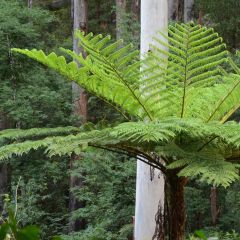
Cyathea cooperi - Australian Tree Fern
- Height at maturity 5,50 m
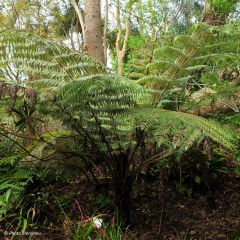
Cyathea dealbata - Silver Tree Fern
- Height at maturity 4,50 m
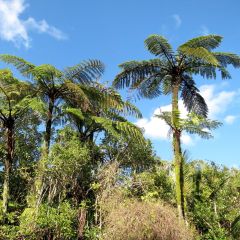
Cyathea medullaris - Black Tree Fern
- Height at maturity 5 m
Planting
Where to plant?
As the Cyathea is a tender plant, it is preferable to grow it in a pot and bring it indoors for the winter, except in regions where the risk of frost is very low (Mediterranean coast, Breton coastline…), where one can attempt to plant it in the ground. However, the species Cyathea australis is slightly more hardy than the others, as it can tolerate temperatures down to -12 °C.
Like most ferns, it does not tolerate scorching sun, and it is better to place it in partial shade. It also thrives in a humid atmosphere and cool, rather acidic soil. It does not like alkaline conditions.
With its gigantic fronds, the Cyathea can reach up to 3-4 metres in span. If you plant it in the garden, ensure there is enough space so it does not feel cramped.
When to plant?
We recommend planting the Cyathea in spring, as soon as there is no longer a risk of frost.
How to plant?
In the ground:
- Start by soaking the pot in a basin filled with water to rehydrate the root ball.
- Dig a large planting hole, which should be about three times the size of the root ball.
- Add well-decomposed compost to enrich the soil,
- Gently remove the Cyathea from its pot and place it in the planting hole, ensuring that the stipe is upright.
- Replace substrate all around to fill the hole, and lightly firm it down with the flat of your hand.
- Water generously the soil as well as the stipe.
- We also recommend staking the stipe during the first few years, so it remains upright until the fern is well-rooted.
In a pot:
- Choose a large pot.
- Fill it with a rich, light substrate. You can make a mix of potting soil and garden soil, to which you can add some bark, sand, and heather soil.
- Place the Cyathea in the centre of the pot, ensuring that the stipe is upright.
- Replace potting soil all around.
- Water generously the substrate and the stipe.
- Place the fern in a conservatory, or outside if there is no risk of frost, sheltered from direct sunlight and wind.
For more information, feel free to consult our advice sheet on planting tree ferns.
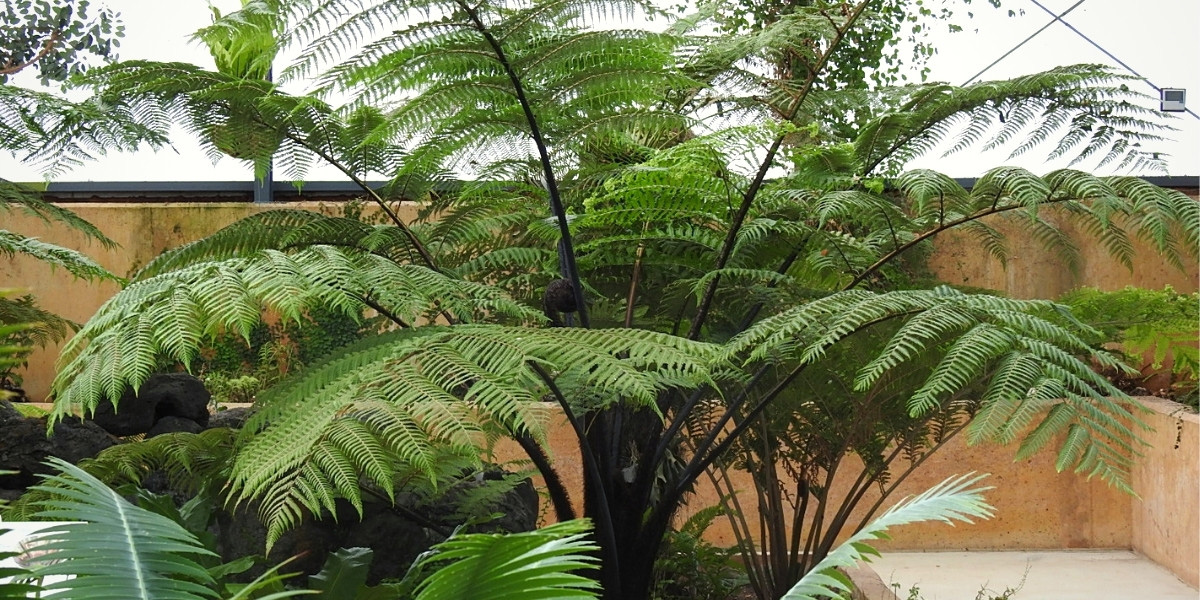
Cyathea medullaris (photo JBCLM)
Read also
Planting arborescent fernsEntretien
We recommend installing the Cyathea on a partially shaded terrace as soon as there is no longer a risk of frost, then bringing it indoors for the winter, for example in a conservatory, with filtered light.
Water it preferably with rainwater rather than tap water, as the latter may be too chalky for it. It is important to keep the stipe moist: when watering, apply water to the top of the stipe, at the centre of the crown of fronds. It will naturally run down the stipe. You can also install a drip irrigation system, placing the drippers at the top of the stipe.
The Cyathea enjoys high humidity (air moisture level). Whether outdoors or in a greenhouse, we recommend installing a misting system. You can also spray a little non-chalky water daily on the foliage.
We advise adding a little liquid fertiliser, diluted in non-chalky water, once or twice a week from spring to autumn. Preferably choose a mineral fertiliser, rather than an organic one, which could burn its roots. For the Cyathea, the fertiliser should be at least twice as diluted as indicated on the packaging. It responds quickly to fertiliser application.
Even if the fronds are damaged by the cold, or if you cut them, the Cyathea can regrow as long as its terminal bud (located at the top of the stipe, at the centre of the crown of fronds) is intact. It should be able to produce new fronds in spring.
Feel free to add a layer of organic mulch around the stipe to keep the soil cool and prevent it from drying out. Additionally, as it decomposes, this mulch will enrich the soil.
If you are growing the Cyathea outdoors, protect it for winter by tying the fronds together around the heart of the fern to shield the apical bud. You can also place a layer of straw or dried fronds on top of it, then surround everything with fleece. With winter protection, Cyathea cooperi can withstand brief frosts of around –5 °C.
If the soil is not well-draining and tends to retain water, the Cyathea may be affected by Rhizoctonia, which causes its roots to rot. If this is the case, you will need to improve drainage by adding coarse sand, for example, or move it to a location where water drains more easily, such as on a small mound or slope.
Multiplication
Sowing Spores
It is possible to collect and sow the spores of Cyathea. However, sowing is delicate and requires time before new ferns can be obtained. You will need to wait several years before seeing the Cyathea form a true stipe.
- Fill a seed tray with a light, sieved substrate, such as a mix of potting soil and sand.
- Moisten it, then place it in the microwave for 10 minutes to sterilise it.
- Wait for it to cool, then sow the Cyathea spores by dispersing them on the surface. Be careful as they are extremely fine! You can use an envelope or a piece of paper to place the spores on and gently tap it to better distribute them on the surface of the substrate. Unlike seeds, spores should not be covered with potting soil.
- Cover the seed tray with plastic film to create a humid and sterile atmosphere, thus limiting the development of fungi or mosses.
- Place the seed tray in a bright location but out of direct sunlight, at a temperature of 18 to 20 °C.
Subsequently, if you notice that the substrate is drying out, do not hesitate to mist it with a little water, as humidity is essential for fertilisation and the emergence of new ferns. Finally, as soon as the seedlings reach a size that allows for handling, repot them into individual pots.
For more information and advice, consult our sheet “How to Sow Fern Spores?”
Association
The Cyathea is ideal for creating an exotic and lush atmosphere. Even if you grow it in a pot, you can take it outside in summer and place it near your terrace, surrounded by plants with an exotic style. It will particularly complement generous and lush foliage, such as that of Tetrapanax, Datisca cannabina, Fatsia japonica, Cycas revoluta, Gunnera, giant Hostas… You can also incorporate other ferns, more modest, such as osmunda, Matteucia struthiopteris, and Woodwardia fimbriata. Also discover the splendid Blechnum novae-zelandiae!
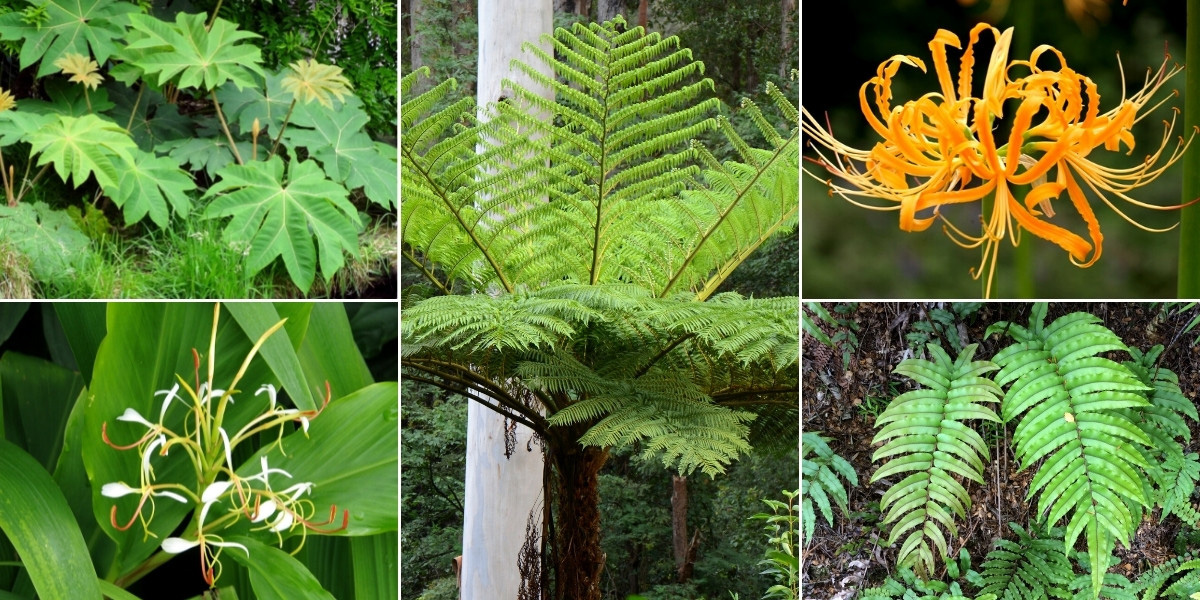
The Cyathea is ideal for creating an exotic decor, alongside other plants with lush foliage! Tetrapanax papyrifera ‘Rex’, Cyathea cooperi, Lycoris aurea (photo J.M. van Berkel), Hedychium spicatum (photo peganum), and Blechnum novae-zelandiae (photo Muriel Bendel)
And if you want to add a bit of colour, incorporate some exotic and original flowers, such as those of Hedychiums, Cannas, Crinum powellii… For a truly exceptional garden, focus on rare bulbs: Cardiocrinum giganteum, Gloriosa, Galtonia, Sprekelia formosissima, Scadoxus multiflorus… These bulbous plants offer spectacular blooms! We particularly recommend the Lycoris aurea, which produces very original yellow flowers around October. However, be cautious as it is a tender plant that will need protection in winter.
Finally, do not hesitate to associate the Cyathea with other tree ferns, such as Dicksonia antarctica.
Useful resources
- To learn everything about ferns and their cultivation, discover our sheet “Ferns: Planting and Growing”
- Feel free to check our sheet “Planting Tree Ferns”
- For further reading, consult the book Hardy Ferns for the Garden, by Cédric Basset and Olivier Ezavin, published in 2013 by ULMER
- If you love tree ferns, also discover Dicksonias
- Subscribe!
- Contents































Comments